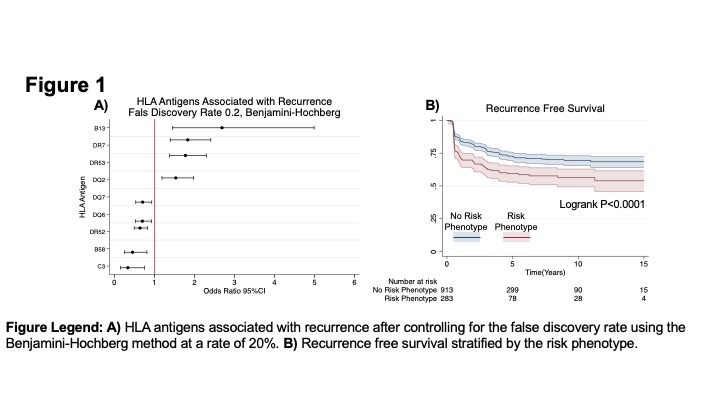Hla Antigens and Recurrence of Focal Segmental Glomerulosclerosis in Pediatric Kidney Transplantation
1Surgery, Duke University, Durham, NC, 2Biostatistics and Bioinformatics, Duke University, Durham, NC, 3Pediatrics, Duke University, Durham, NC
Meeting: 2021 American Transplant Congress
Abstract number: 76
Keywords: Graft failure
Topic: Clinical Science » Kidney » Kidney: Pediatrics
Session Information
Session Time: 6:00pm-7:00pm
 Presentation Time: 6:05pm-6:10pm
Presentation Time: 6:05pm-6:10pm
Location: Virtual
*Purpose: Recurrence of focal segmental glomerulosclerosis (FSGS) reduces graft survival yet risk factors remain elusive. While HLA risk alleles are known to be associated with primary nephrotic syndrome, we sought to determine the role of HLA in post-transplant recurrence.
*Methods: Kidney transplant recipients under 19 years old diagnosed with FSGS were obtained from the Scientific Registry of Transplant Recipients. Simple logistic regression was performed to relate recipient HLA antigen and recurrence. The false discovery rate was controlled using the Benjamini-Hochberg method. For recipient HLA antigens associated with recurrence, we also examined the association of donor HLA and concordance between donor and recipient HLA and recurrence. Multiple logistic regression including HLA and clinical characteristics was performed to predict recurrence.
*Results: Recipients who recurred were younger and had lower albumin; no association between deceased or living donor type and recurrence was seen (Table 1). Recipient HLA antigens B13, DR7, DR53, and DQ2 were associated with increased recurrence while DQ7, DQ6, DR52, B58 and C3 were associated with decreased recurrence (Figure 1A). HLA-DR7, DQ2, and DR53 presented as co-linear variables and represented a potential risk phenotype for recurrence (OR 1.92 95% CI [1.44-2.50]). This risk phenotype was associated with a shorter recurrence free survival (Figure 1B, Logrank p<0.0001). Donor organs with the risk phenotype did not significantly increase risk of recurrence, even in cases where recipient and donor both possessed the risk phenotype. DQ7 concordance between donor and recipient was associated with decreased recurrence (OR 0.36 95% CI [0.22-0.59]). Our multivariable model had moderate predictive value (c-statistic 0.67).
*Conclusions: Certain HLA antigens were found to associate with either increased or decreased risk of recurrent FSGS post-transplantation. Validation of HLA risk alleles could impact risk assessment and donor selection in this population.
| No Recurrence N=943 |
Recurrence N=388 |
p-value | |
| Gender(F)-n(%) | 399(42) | 173(45) | 0.45 |
| Age at Transplant-Med(IQR) | 16(12-18) | 14(10-17) | <0.001 |
| Race Asian Black Multi Native Pacific White |
29(3)
364(39)
13(1)
5(1)
3(0)
529(56)
|
7(2)
131(34)
7(2)
2(1)
5(1)
236(61)
|
0.11 |
| Ethnicity(Latino)-n(%) | 265(28) | 87(22) | 0.033 |
| Deceased Donor-n(%) | 705(75) | 278(72) | 0.24 |
| Living Related Donor-n(%) | 184(20) | 84(22) | 0.38 |
| Albumin(g/dL)-Med(IQR) | 3.7(3.2-4.2) | 3.3(2.3-3.8) | <0.001 |
To cite this abstract in AMA style:
Shaw BI, Ochoa A, Chan C, Gbadegesin RA, Jackson AM, Chambers ET. Hla Antigens and Recurrence of Focal Segmental Glomerulosclerosis in Pediatric Kidney Transplantation [abstract]. Am J Transplant. 2021; 21 (suppl 3). https://atcmeetingabstracts.com/abstract/hla-antigens-and-recurrence-of-focal-segmental-glomerulosclerosis-in-pediatric-kidney-transplantation/. Accessed December 20, 2025.« Back to 2021 American Transplant Congress

